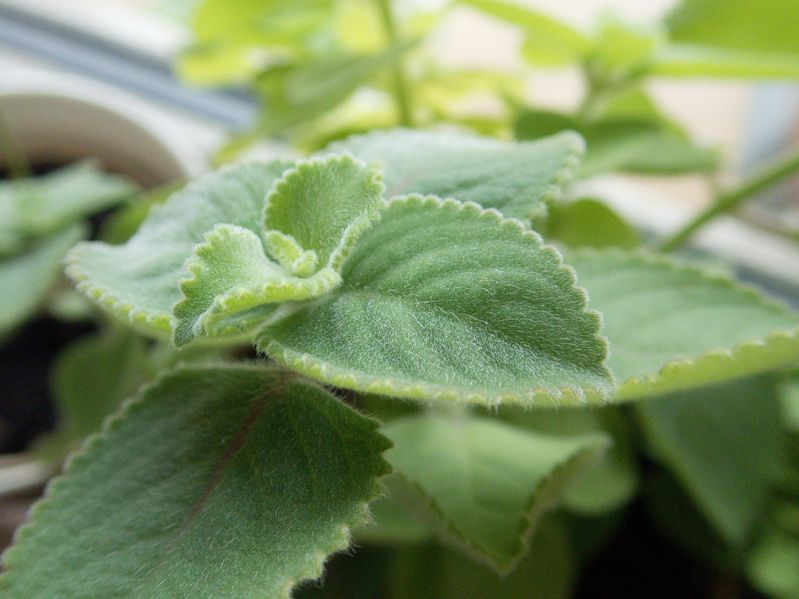Lemon Scented Indian Borage - Plectranthus amboi

Common Names: Lemon Scented Indian Borage, Indian Borage, Cuban Oregano, Mexican Mint, Spanish Thyme, Mexican Thyme, Thick Leaf Thyme, Silver Spurflower, Plectranthus amboinicus, Plectranthus aromaticus, Coleus amboinicus, Coleus aromaticus, Oregano Cubano, International: Indian Borage, Cuban Oregano, Latin: Plectranthus amboinicus, Origin: Africa, Asia
Latin Name: Plectranthus amboinicus
Origin: Asia, Australia, Europe, South America, North America
Short Introduction
Lemon Scented Indian Borage is an easy-care plant, highly adaptable to mild climates. It tolerates typical indoor conditions and can be grown as a houseplant in winter, or even as a balcony herb in summer. It needs plenty of light and should be watered only moderately.
The plant dislikes frequent or excessive watering but requires little other attention. It does not tolerate frosty air. In spring, it is recommended to repot, fertilize, and pinch back the plant. Propagation can be done from cuttings in sandy soil or from seeds. It thrives in partial shade or a cool, south-facing location. Ideal daily temperatures range between 22 and 28°C, but the plant can tolerate much lower temperatures, even down to 10°C.
Detailed Description
Lemon Scented Indian Borage, also affectionately known as the "grandmother's remedy for the common cold," is renowned for its distinctive aroma and beneficial properties.
Botanical Information
Lemon Scented Indian Borage is a deciduous shrub belonging to a group of plants containing menthol. This herb grows up to 1 meter tall and is relatively broad. It features hairy, oval-shaped, 5–10 cm long and 3–5 cm wide, gently serrated, aromatic leaves that release their strongest scent when crushed or rubbed fresh. Fine, pale hairs on its surface give the plant a light green to silvery hue. The flowers grow at the terminal end of the plant and display a bluish-white color.
Origin and Distribution
The plant is originally from the eastern coast of Africa; however, its current natural range spans across all of Africa, Asia, South America, the Caribbean, and parts of the Pacific.
Usage / Dosage
According to the legislation of the European Parliament and Council (EC) No 1924/2006 on nutrition and health claims, we are unable to provide detailed information on the positive effects of this plant on the human body. For details on its effects, please consult freely available sources online or in specialized literature.
Culinary Uses
Lemon Scented Indian Borage is a versatile and hardy plant, serving as both a natural insect repellent and a culinary herb. The fresh leaves are fully edible and feature a flavor reminiscent of oregano with a spicy minty essence. In the kitchen, an easy rule of thumb is to use it anywhere you might use sage. Its delicious taste and delightful fragrance make it a standout addition in many dishes.
Traditional Medicine
In Australian Aboriginal medicine, crushed leaves are applied to mildly healed wounds for their mild anti-inflammatory and antifungal effects, and are also used for burns, insect bites, and skin allergies. These uses are widespread in areas where the plant is found—being especially popular in Brazil.
In Arabia, it is well-regarded for treating rashes (including in children), skin irritations, and as a local antiseptic. In India and Africa, the plant is used to support digestion, relieve indigestion, diarrhea, and as a carminative.
In Australia, Lemon Scented Indian Borage is valued as an outstanding natural repellent—its aromatic oils repel many types of nuisance insects.
The plant is widely recognized in folk medicine as a digestive aid, and is also used for skin conditions, respiratory complaints, infections, and much more. Research studies have partially validated these traditional uses in various regions of the world.
Traditionally, Lemon Scented Indian Borage is used to support relief during nasal congestion and colds. It is said that simply having the plant in a room can improve breathing. Folk remedies often prepare a tea by steeping about five washed leaves in hot, slightly cooled boiled water, sweetened with honey, served as warm as possible. For fever and headaches, it is widely utilized in traditional healing practices throughout Asia and South America.
In India and the Amazon, it is also used for urinary tract infections. In African countries, it is used to help reduce inflammatory processes and for snake bites.
The plant is traditionally administered for chronic cough, asthma, bronchitis, and sore throat especially in India and the Caribbean. Animal model studies have confirmed bronchodilatory effects and mild activity against Mycobacterium tuberculosis.
Other herbals recommend preparing a syrup from the leaves. For use, the leaves are crushed, mixed with sugar and a little water, and given to children 3 times daily when needed.
Active Compounds
Lemon Scented Indian Borage contains an array of beneficial compounds, most notably tannins, polyphenolic acids, terpenoids, flavonoids, and various other organic acids, alongside vitamins C, A, and E. Its essential oil contains compounds similar to those found in culinary aromatic herbs such as basil and sage. The most frequently mentioned actives include limonene, selinene, ionone, humulene, borneol, camphene, beta-felandrene, thujene, linalool, myrcene, and thymol, with menthol also being significant.
Traditional Dosage
To make a repellent, steep the leaves in boiled water, strain the extract, and add vinegar. Store in the refrigerator and apply as needed. Typically, about half a cup of chopped leaves and half a liter of water are used.
For respiratory discomfort, crush the leaves and combine with sugar and a small amount of water. This mixture can be administered to children 3 times daily.
